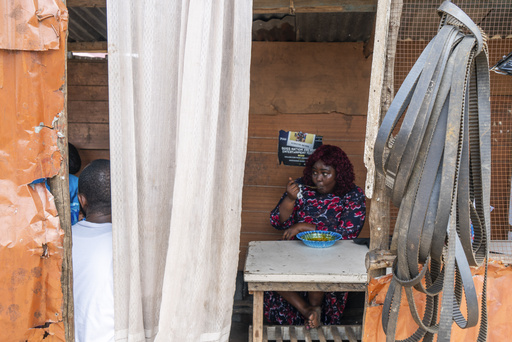
FREETOWN, Sierra Leone — In Sierra Leone, rice holds a revered status; locals often express that a meal is incomplete without it. Yet, as prices climb significantly, many residents are forced to forgo other foods just to afford rice. As a result, approximately 83% of the population is facing food insecurity, as reported by the United Nations’ World Food Program.
In the capital city of Freetown, 28-year-old Anima Mangola, a nail technician, enjoyed a dish of rice accompanied by stewed cassava leaves. “I could easily eat rice five times a day if I had the money,” she lamented, noting that rice prices have more than doubled this year. While some individuals manage to keep pace with rising costs, many others are struggling, leading to widespread hardship.
Experts attribute the escalating prices to the country’s heavy dependence on imports to meet the demand for rice, which accounts for around 35% of the rice consumed and costs the nation over $200 million every year in foreign currency. Despite West Africa’s rich heritage of rice cultivation and favorable agricultural conditions, the reliance on imports stems from insufficient investment in agriculture, rapid population growth, and the influx of cheap rice from Asia.
Agriculture Minister Henry Kpaka Musa has pointed out that historical pressures from the International Monetary Fund in the 1980s led Sierra Leone to halt agricultural investment and open its markets to imports as a condition for foreign aid. “At one point, we even exported rice,” he reminded during an interview.
Presently, Kpaka and President Julius Bio are ambitiously pursuing a return to self-sufficiency in rice production. This year, they secured over $620 million from international development banks to advance their goal. However, the overall financial framework for achieving self-sufficiency is estimated to necessitate around $1.8 billion. Experts at the Ivory Coast-based research institute, Africa Rice, have praised this initiative as “ambitious and forward-thinking.”
Nevertheless, non-governmental organizations and academics caution that this initiative may favor large-scale agribusinesses at the expense of Sierra Leone’s estimated 5 million smallholder farms. They cite previous unsuccessful attempts at attaining food self-sufficiency in nations like Burkina Faso and Ghana as reasons for concern.
West Africa’s rice-growing tradition spans an impressive 3,500 years. Historian Judith Carney has documented how these farmers were forcibly taken as slaves to cultivate plantations in the southern United States, giving rise to a prosperous rice economy. Despite possessing the region’s most suitable climate and land for rice production, Sierra Leone still faces obstacles, including poor infrastructure that hampers market access, inconsistent electricity for processing, the impacts of climate change, and limited financial support for farmers.
With the backing of development banks, the agriculture ministry is working to enhance roads connecting major rice-producing areas to markets, establish extensive irrigated territories, and provide fertilizers, seeds, and pesticides to smallholder farms. Kpaka stated, “The plan begins with infrastructure to draw in private investment,” while promoting opportunities to international investors for thousands of hectares of irrigated farmland.
However, concerns arise that smallholder farmers, comprising 70% of the nation’s 8 million residents, may be sidelined under the current strategy. In the Bo district, local farming leaders, including Eric Amara Manyeh, voiced their struggles regarding land access, inadequate storage, and the need for training and processing facilities, while expressing skepticism towards government support based on past experiences.
Among the main worries raised by farmers is the lack of available labor to develop irrigated fields. Installing irrigation channels and clearing vegetation requires considerable effort, and the urban migration of young people has made hiring additional labor prohibitively expensive for many farmers. Even with high unemployment rates in cities, Manyeh mentioned that many youths opt for less strenuous jobs, like riding motorcycle taxis.
While some farmers have formed cooperatives to share labor costs, the inefficiency is evident, as illustrated by one government-supported project that took a team of 82 workers three months to dig channels over 60 hectares (148 acres).
Sierra Leone’s aim to supply smallholders with fertilizers, seeds, and pesticides echoes the Green Revolution in Asia, which propelled a significant increase in rice production within two decades. However, Klara Fischer, a rural development expert, warns that these efforts might entangle local farmers with large agribusiness companies like Bayer Crop Science and Syngenta. Fischer highlighted the distinction between the circumstances of Asian farmers in the 1970s and those in Africa today, particularly due to labor availability.
Despite some valid concerns, Kpaka remains optimistic, believing that the essential ingredient for growth is solid infrastructure to enable farmers to process and sell their rice, motivating them to boost production. “Without adequate roads, farmers will always remain in subsistence farming,” he stated.
Conversely, others suggest that Sierra Leone should allocate its financial resources towards empowering smallholder farms instead of catering to corporate interests. Joseph Randall, director of the environmental NGO Green Scenery in Sierra Leone, advocates for sustainable practices, such as organic composting, to replace reliance on imported chemical fertilizers that contribute to climate change.
Randall also opposes the distribution of modern seeds, which, though higher yielding, are patented by agribusiness firms and cannot be replanted by farmers. Meanwhile, Manyeh stands in his plantation, as thunder rumbles overhead, illuminating a swamp area that could contribute to the nation’s self-sufficiency initiative. “The willingness is present, and the potential exists,” he affirmed, yet he understands that realizing this potential requires more than mere promises to successfully nourish a nation.
